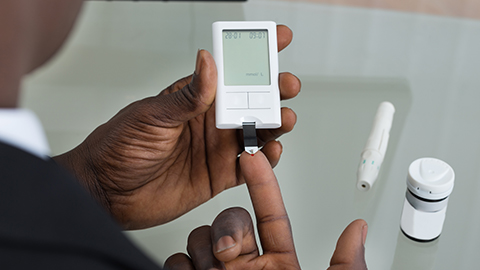
A client with diabetes has a 100-point blood sugar crash during his massage session. Luckily, the client was prepared and knew what to do. But can massage therapists do anything to avoid this risk? Listen in to find out.
Resources:
Lyu, W.B. et al. (2019) “Effect of Self-Acupoint Massage on Blood Glucose Level and Quality of Life in Older Adults With Type 2 Diabetes Mellitus: A Randomized Controlled Trial,” Journal of Gerontological Nursing 45, no. 8: 43–48. https://doi.org/10.3928/00989134-20190709-05.
Sajedi, F. et al. (2011) “How effective is Swedish massage on blood glucose level in children with diabetes mellitus?,” Acta Medica Iranica 49, no. 9: 592–597. https://pubmed.ncbi.nlm.nih.gov/22052142/.
Silva, N. C. M. et al. (2018) “Effect of Foot Reflexology on Capillary Blood Glucose, Tissue Temperature, and Plantar Pressure of Individuals with Diabetes Mellitus (Type 2): A Pilot Study,” Journal of Chiropractic Medicine 17, no. 3: 182–189. https://doi.org/10.1016/j.jcm.2018.03.003.


This podcast sponsored by:
About Anatomy Trains:
Anatomy Trains is a global leader in online anatomy education and also provides in-classroom certification programs forstructuralintegration in the US, Canada, Australia, Europe, Japan, and China, as well as fresh-tissue cadaverdissectionlabs and weekend courses. The work of Anatomy Trains originated with founder Tom Myers, who mapped the human body into 13 myofascial meridians in his original book, currently in itsfourthedition and translated into 12 languages. The principles of Anatomy Trains are used by osteopaths,physicaltherapists,bodyworkers,massagetherapists,personaltrainers,yoga,Pilates,Gyrotonics,and other body-minded manual therapists and movement professionals. Anatomy Trains inspires these practitioners to work with holistic anatomy in treating system-wide patterns to provide improved client outcomes in terms of structure and function.
Website:anatomytrains.com
Email:info@anatomytrains.com
Facebook:facebook.com/AnatomyTrains
Instagram: instagram.com/anatomytrainsofficial
0:00:00.0 Speaker 1: Ruth Werner's best-selling book, A Massage Therapist's Guide to Pathology is a highly regarded, comprehensive resource that sets the standard for pathology education. Written for massage therapy students and practitioners, this ground-breaking resource serves up a comprehensive review of the pathophysiology, signs, symptoms and treatment of more than 500 diseases and disorders. Learn more at booksofdiscovery.com.
0:00:32.7 Speaker 2: Anatomy Trains is delighted to announce a brand new dissection live stream specialty class on September 18th. Lumbopelvic stability, a one-day layer dissection with Anatomy Trains author Tom Myers and master dissector Todd Garcia. The early bird price of $150 is held until September 10th. After September 10th, the price is $250. Come, see the body's actual core for yourself. This course will be provided over Zoom webinar with multiple camera views, live chat and Q&A. Visit anatomytrains.com to sign up.
[music]
0:01:15.6 Ruth Werner: Hi, and welcome to "I Have a Client Who... ", Pathology Conversations with Ruth Werner, the podcast where I will discuss your real life stories about clients with conditions that are perplexing or confusing. I'm Ruth Warner, author of A Massage Therapist's Guide to Pathology, and I have spent decades studying, writing about and teaching about where massage therapy intersects with diseases and conditions that might limit our client's health. We almost always have something good to offer, even with our most challenged clients, but we need to figure out a way to do that safely, effectively and within our scope of practice, and sometimes as we have all learned, that is harder than it looks. Today's story comes from a massage therapist who shared a situation with a good outcome, but it involved a valuable takeaway lesson.
0:02:10.1 RW: And the story goes like this. Teachable moment for me, I just had a client with Type 1 diabetes have a 100-point blood sugar drop over the course of what seemed like a pretty benign low circulation session. I've worked on this person before without an issue. Thankfully, he recognized the signs of hypoglycemia and we ended the session and got him to his car where he had appropriate food. What I had never considered is that all the snacks in my office are low carb and we're totally useless in that situation. I will keep a pack of carb available granola bars in my office in the future. He attributed the large drop to a very poor night's sleep, which seems to cause an increase in fluctuations for him. We'll need to come up with a different strategy for any future sessions. I'm used to having clients experience smaller blood sugar and blood pressure changes, but that's the first time I've had one with that degree of fluctuation. Just a public service announcement reminder that massage affects many systems and sensitive clients are always capable of having adverse reactions.
0:03:17.9 RW: So there's a lot to unpack here. First off, kudos to this massage therapist for sharing this and for anticipating how to avoid another event like this. I want to talk about diabetes, but just Type one for today, and I wanna talk about what the research says about massage for people with diabetes, especially about drops in blood sugar. And I want to mention some good strategies about how to help clients who are having a blood sugar crash, and I wanna point out that this is an incredibly complex condition with repercussions for the cardiovascular system, the kidneys, the skin, and much more. In fact, whenever a medical professional asks me, "Why do massage therapists need to know about pathology?" My one word answer is, "Diabetes." But for today, we're just going to focus on blood sugar and Type 1 diabetes, but this is me inviting your, "I Have a Client Who" stories about people with Type 2 diabetes, which is about 10 times more common, so I know you're out there, please send me your stories.
0:04:24.0 RW: Diabetes mellitus, when we translate this term, it means flowing through sweetness, and this comes from early observations that with this condition, people urinate a lot and their urine is sweet. Mel is a word root for honey, so literally, this name means sweet pee. Type 1 diabetes is an autoimmune disorder. In this situation, the immune system destroys the insulin-producing cells of the pancreas. Now, when I was in massage school, we called those cells Islets of Langerhans, which always sounded to me like a lovely place for a honeymoon, but now we call these cells beta cells, less romantic, more technical. In any case, the beta cells of the pancreas produce insulin. And do you remember what insulin does? Of course, you do. Insulin pulls sugar out of the bloodstream and delivers it to hungry cells, especially red blood cells, muscle cells and neurons in the central nervous system. All these cells and many others rely on glucose as a fuel source, and it's a great one. When we burn sugar for energy, the leftovers are carbon dioxide and water. When we burn other sources of nutrition like proteins or fats for energy, there's a lot more residual waste. So we have these hungry cells and we have sugar in the blood, and the job of the insulin is to escort the sugar into the cells, that's the only way sugar can cross the cell membranes. If we don't have insulin, sugar accumulates in the blood, that's hyperglycemia, and it's not good for our blood vessels.
0:06:12.5 RW: Also, insulin has a role in how we manage fat, but that's a whole other story. But more than that, if our blood glucose gets really high, it's bad for our blood vessels, but it's really, really bad for the kidneys, and this is why diabetes is a major contributor to heart disease, and also the number one reason people get on the waiting list for a new kidney. People with Type 1 diabetes like the client in this story, can't make their own insulin because their immune system killed off their beta cells. This usually happens in childhood or early adolescents, but it can have an adult onset too. The only way these folks can survive is by supplementing insulin, and insulin can't make it through the environment of the stomach or through the first pass through the liver that we have for other drugs, so it has to be administered by injection with a single-use syringe or an insulin pen or by way of a pump. So here is what happens to blood sugar levels for people with diabetes and for people without. We wake up in the morning after a 14 to 16 hour fast and our blood glucose is low, we eat something, our blood glucose rises. How fast it rises depends on what we ate. Oatmeal with chia seeds and a banana will have a different effect on blood sugar than chocolate covered sugar bombs or the real breakfast of champions, a Diet Coke and a Snickers bar. In any case, blood glucose rises.
0:07:47.5 RW: Now, for a person without diabetes, we secrete insulin, and this carries all that blood glucose into hungry cells, and then our blood glucose levels fall again gradually for the oatmeal, really fast for the candy. But if a person has Type 1 diabetes, they have to inject insulin and hope that they inject a dose that is within the range of what they need for that particular meal, and this cycle of repeats on a four to six hour schedule throughout the day. Now, I've left out a lot of steps here, like how the liver releases glucagon and what insulin does to other tissues, but you get the gist of the blood glucose cycle, I hope. Depending on how well this client manages his diabetes, here's what might have happened for him. He ate a meal, he took his regular dose of insulin, which went right to work, lowering his blood glucose, feeding his hungry cells. Awesome. And then he got on a massage table, which also lowers blood glucose. Awesome, maybe. Plus, he didn't sleep well, and that makes his cycle less predictable. And the combination of all these factors led to a rapid drop, a hundred points in a short period, in short very, extremely not awesome. Now, in this situation, the client knew what was happening. He knew his blood sugar was low and he knew how to fix it. He needed to eat something with sugar in it, stat, and he had to go get something from his car, which was great.
0:09:27.4 RW: I just hope he didn't try to drive until he felt more stable, but what if? What if he didn't recognize the signs of hypoglycemia and his massage therapist didn't either? What if he didn't have a snack handy, and his massage therapist didn't either? What if he did drive away and then maybe passed out in traffic? Now, this contributor doesn't describe the signs of hypoglycemia, just that the client recognized that it was happening. The specific citation of a 100 point drop suggests that the client keeps test strips, which is not always going to happen. What other ways do we have to watch for this potentially dangerous drop in blood glucose? Well, that depends on the individual. I was on hand when a good friend of mine who had Type 1 diabetes had a crash while we were waiting for dinner in a restaurant. She had taken her shot early in anticipation of eating, but the meal took longer than we expected to get to the table. She stayed upright and smiling while that insulin was draining away her blood sugar, but she essentially checked out. She nodded at the conversation, she didn't speak, her eyes were blank, she didn't respond to her name, she was probably on the brink of falling over when another guest at the table noticed and got her some juice right away.
0:10:45.0 RW: Other early signs might be familiar to a lot of us. An occasional drop in blood glucose isn't that uncommon, even for people who don't have diabetes, and these signs include things like shaking and dizziness and sweating and hunger and rapid heartbeat, and some level of confusion, and if it gets extreme, this can topple over into abnormal behavior and blurred vision and auditory hallucinations and seizures and loss of consciousness. So this client's self-awareness was critical to his managing that situation before it got dangerous. And this is especially lucky because one of the complications of diabetes is ironically, loss of the ability to sense changes in blood sugar. Blood sugar crashes do not turn up in the literature as an adverse effect relating to massage therapy, at least not where I've seen it, but we know this happens anecdotally. We can combine these observations with data that does suggest massage contributes to some level of blood glucose dropping, and this could be connected to a parasympathetic response. We need less sugar in the blood ready to be burned by muscles and other cells if we are feeling relaxed and safe. Right? So what does the research say about massage and blood glucose? I will attach a few links in our show notes to some interesting studies.
0:12:07.8 RW: Most of the time, research suggests that massage leads to a drop in blood glucose. There was one study with foot reflexology that found no change. These studies are mostly done with adult Type 2 diabetes patients. Some of them only look at before and after readings for one session, but one study looked at massage for children with diabetes. We can infer from that that they're talking about Type 1 and they had a very positive finding over time. But exactly how much does blood glucose drop and for how long, that's impossible to predict. It will vary so much on each individual's response to the touch of their therapist, right. We may someday find that certain types of massage have more effect on blood glucose levels than others, but we're a long way off from that kind of refinement.
0:13:00.0 RW: In the meantime, how do we practice as safely as possible for our clients who have diabetes. Well, I have a few ideas. One, for our clients who have diabetes, let's always be watchful for signs of hypoglycemia, and let's recruit them to be watchful with us. Let's find out ahead of time what they'd like us to do if they feel a little unsteady after their massage. A granola bar, a piece of candy, a sip of milk. Different people will have different preferences. Many people who have diabetes carry Glucose tablets with them just in case, and we should know how to access them in case there's an emergency. And lastly, to the extent that it's possible, it's a great idea to schedule sessions in the middle of that insulin blood glucose cycle, not at the beginning when someone has just taken insulin with a meal, and not at the end when someone's hungry and their blood glucose is dropping fast. This may not always be possible, but we can ask our clients to consider it when they make their appointments. I'm really glad this worked out so well for today's contributor and for their client, and I'm grateful for our contributor who allowed me to share this story 'cause I think it's probably useful for a lot of people, and it allowed me to cover some fairly simple steps we can take to minimize any risk of a blood sugar crash for our clients who live with diabetes.
0:14:25.8 RW: Hey everybody, thanks for listening to, "I Have a Client Who... " Pathology Conversations with Ruth Werner. Remember, you can send me your "I Have a Client Who" stories to, ihaveaclientwho@abmp.com. That's, I have a client who, all one word, all lowercase at A-B-M-P dot com. I can't wait to see what you send me and I'll see you next time.